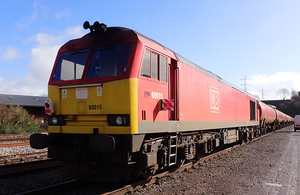Track damage between Pencoed and Llanharan
Track damage between Pencoed and Llanharan, South Wales, 6 March 2021.

Train 6A11 at Bristol after the events
At around 02:10 hrs on Saturday 6 March 2021, train reporting number 6A11, the 21:25 hrs freight service from Robeston (Milford Haven) to Theale, caused damage to the track that it travelled over on the part of its journey between Pencoed and Llanharan, including two broken rails. The train, which did not derail, stopped beyond Cardiff Central station following a call from the signaller to the driver informing them of a possible problem with the train. The driver was instructed to continue over the wheel impact load detection system at Marshfield, to try and confirm suspicions that wheel flats had caused the track damage. The detection system did not highlight any problem with the train, which was then allowed to continue on its journey. The train was finally stopped in the Horfield Junction area, near Bristol, after a report of it making unusual noises was made by staff at the maintenance depot at Stoke Gifford.
The train consisted of a locomotive and 23 tank wagons loaded with petroleum products. Examination of the train found that part of the brake rigging on the leading bogie of the eleventh wagon had become detached, and that the trailing pair of wheels on that bogie had suffered significant damage (wheel flats). Some of the components of the braking system were missing altogether. Upon inspection, several other wagons in the train also showed evidence of wheel tread damage, possibly consistent with their wheels having stopped rotating at times during the journey.
The RAIB’s preliminary examination has concluded that the brakes of all the wagons in the train were almost certainly properly released when the train left Robeston. It appears that some sets of wheels ceased to rotate at some point during the journey, leading to the development of the wheel flats, and began to turn again, possibly after the train had come to a stop at Margam for a change of driver. The impacts from the rotating, damaged, wheels, particularly those on the eleventh wagon, gave rise to the broken rails, and may also have caused the damage to the brake rigging on that wagon.
Our investigation will aim to establish the sequence of events and determine why the wheels behaved in this way, and why the braking components failed. It will examine how the developing incident was handled by the Network Rail operating staff along the route, and consider any underlying management factors. Our investigation will also explore any similarities to the events leading to the derailment at Morlais Junction in August 2020, which is the subject of an on-going RAIB investigation, and to the track damage incident between Ferryside and Llangennech in 2017, which is described in RAIB report 17/2018.
The draft investigation report into this accident will start formal consultation with industry in January. Publication of our final investigation report is now expected to be in March.
Our investigation is independent of any investigation by the railway industry or by the industry’s regulator, the Office of Rail and Road.
We will publish our findings, including any recommendations to improve safety, at the conclusion of our investigation. This report will be available on our website.
You can subscribe to automated emails notifying you when we publish our reports.